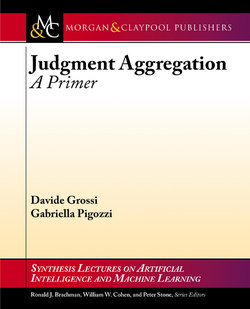Читать книгу Judgment Aggregation - Gabriella Pigozzi - Страница 9
На сайте Литреса книга снята с продажи.
ОглавлениеPreface
This book concerns the aggregation of individual opinions into group opinions. When opinions exhibit logical structure (e.g., accepting that p is the case and accepting that p implies q compels me to also accept that q is the case) aggregation becomes difficult. Is it possible at all to find aggregation procedures that preserve compliance with logical principles, and that at the same time appeal to democratic criteria like, for instance, not being dictatorial? Are the methods we commonly use to aggregate our opinions (e.g., majority voting) appropriate, and under which conditions? And if, after all, ideal procedures turn out to be impossible, what are the reasons for such impossibility? Questions like these are the playground of judgment aggregation, and will be the topic of this book.
Before starting, the reader can find here some information about the main objectives we pursued by writing the book, the readership we aimed at, and an outline of the topics we are going to cover.
Objectives In writing this introductory book on judgment aggregation we had two main objectives in mind. First, we wanted to provide a compact and systematic exposition of the problems, definitions, results and proof techniques that drive the field. Survey papers appeared in philosophical and social sciences journals and volumes [LP09, Car11, Mon11, Lis12], but no comprehensive exposition of the field is available to date. Second, we wanted to make the theory of judgment aggregation accessible, in a ‘sympathetic’ format, to the disciplines of artificial intelligence and multi-agent systems, which in recent years have increasingly been concerned with the problems of aggregation and voting.
Readership and prerequisites The book is primarily meant as an introduction to the field of judgment aggregation for graduate students and researchers in computer science, artificial intelligence and multi-agent systems. At the same time, it has been our aim to make the book accessible also to mathematically minded graduate students and researchers in philosophy, the social and the political sciences. The material is presented in such a way to presuppose only familiarity with propositional logic and basic discrete mathematics. The book intends to put the reader at pace with the field, enabling the key conceptual, technical and bibliographical tools to understand (and possibly contribute to) its current developments. We have not included any exercises, but the reader will be asked at times to complete missing steps in proofs or try to prove statements given as running comments in the main text.
Outline of the book The book is structured in two parts. The first part (Chapters 1–4) introduces what can be considered the established body of the theory: the motivating examples behind judgment aggregation and its place within the field of social choice theory (Chapter 1); the logic-based framework for judgment aggregation (Chapter 2); some results, with proofs, on the impossibility of finding ‘ideal’ aggregation procedures (Chapter 3); and various ways that have been explored in the literature to work around the limits imposed by those results (Chapter 4). The second part (Chapters 5–7) touches upon topics that are, to a greater or lesser extent, still under development in the research agenda of the field: the issue of manipulation and strategic behavior in judgment aggregation (Chapter 5); the design of non-resolute aggregation procedures (Chapter 6); and the modeling of deliberative processes of aggregation, and of processes of pre-vote deliberation (Chapter 7). All chapters present an overview of key concepts and results and conclude with a section pointing to further topics and readings and, sometimes, open issues.
Davide Grossi and Gabriella Pigozzi
December 2013
